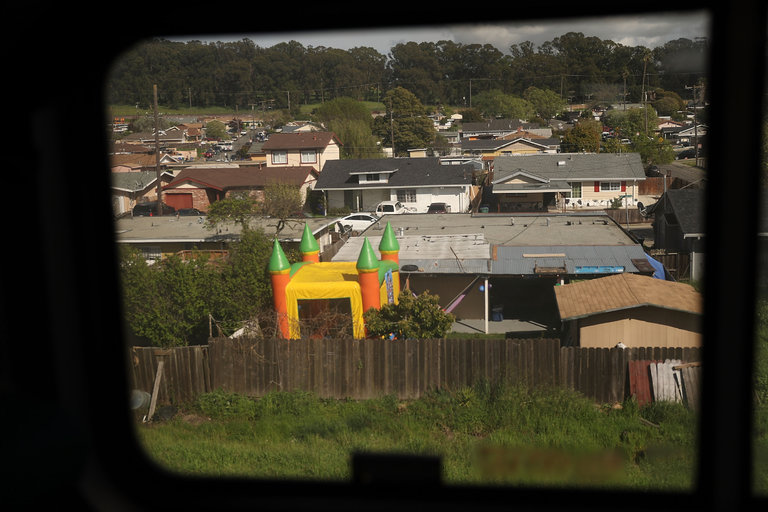
In the News
A Focus on Health to Resolve Urban Ills
-
Focus Areas
Healthy Communities -
Issues
Health in All Policies -
Programs
State of Equity

On a crisp morning in the struggling Bay Area city of Richmond, Calif., Doria Robinson prepares a community vegetable garden for an onslaught of teenagers who will arrive that afternoon. Beyond the farm, a Chevron refinery pumps plumes of smoke into the atmosphere. The farm won’t remove the pollution, but Robinson believes it can make the city’s residents healthier in other ways, specifically by showing them that “their actions have an impact.”
“Down here it’s hard to see what matters,” Robinson says, “that you matter, that your neighborhood matters.”
Robinson is the director of Urban Tilth, a nonprofit organization that is part of a movement in Richmond to counteract chronic stress that stems from the characteristics of the environment — abuse, discrimination, unrelenting economic worries and feelings of marginalization and lack of control — all of which scientists have linked to poor health. Children exposed to domestic violence, for example, develop higher rates of asthma, substance abuse, sexually transmitted diseases and liver disease; H.I.V. has been shown to progress faster in gay men who conceal their homosexuality than in men who live openly, and people living paycheck to paycheck below the poverty line have shorter life spans.
Although evidence for connections between social factors and physical health has mounted for decades, interventions have remained elusive. To figure out what works, more than a dozen jurisdictions across the United States have rolled out a policy regimen titled “Health in All Policies” that has decades-old international roots; it explores new ways to improve health through social transformation, and ways to assess the impact of the changes. Robinson’s farms are among many interventions supported by the new laws. But “Health in All Policies” is part of a broader movement to confront problems before they manifest in illness and casualties. For example, the federal Centers for Disease Control and Prevention has examined the connections between many factors that lead to violence, with a view toward improving prevention and coordination. And the Robert Wood Johnson Foundation, the nation’s largest foundation focused solely on health, has oriented its work around advancing an integrated “Culture of Health.” The Foundation has played close attention to social and economic inequities faced by African-Americans and other minority groups whose health, on average, is worse than average by several measures.
Richmond became an early adopter of “Health in All Policies” in 2009. The basic idea is that considerations of health and health equity should be systemically woven into city plans and budget decisions ranging from transportation to housing. It was widely known that unsafe streets can directly injure an individual. What’s new is the knowledge that health also depends on how people feel when they walk down a tree-lined street rather than one with boarded-up buildings.
The city was ripe for the nascent movement, given its need and its progressive local politics. The need is detailed in grim statistics: A child born in Richmond is expected to die five years earlier, at 77, than one born in nearby San Francisco. More than a quarter of Richmond’s children have asthma, compared with California’s average of 15 percent. Residents also have higher rates of cancer, heart disease and diabetes than the California average. And, as elsewhere, these poor health outcomes correlate with the city’s subpar socioeconomic conditions. In 2010, one in five people in Richmond was unemployed, 38 percent of children lived in poverty, and the city had one of the highest crime rates in the United States.
Further, issues of health inequity are at play. Black people in Richmond have more than twice the rate of heart disease, hypertension and diabetes than white people in the city. Addressing such disparity is a cornerstone of “Health in All Policies” in California, if not always in other parts of the country. The reasoning is that chronic stress can be brought on by the marginalization inherent in unfair access to public services, healthy food and safe neighborhoods.
Richmond officials became interested in “Health in All Policies” about a decade ago, when they spoke with Jason Corburn, an urban planner and epidemiologist at the University of California, Berkeley. Corburn showed that a person’s ZIP code is more predictive of longevity than his or her genetic code — and that Richmond’s ZIP codes did not fare well. The root of the problem wasn’t the individual, he maintained, but rather the environment. “We all knew that it went beyond saying, you are unhealthy because you don’t exercise and eat bad food,” he says. “I talked about toxic stress and structural racism as a driver of poor health outcomes.”
“The police chief immediately got it,” he said, “the mayor got it, and the city manager eventually got it too.”
Over the next few years, Richmond worked on incorporating health and wellness policies within plans for transportation, parks, policy and housing, as opposed to keeping health a separate issue. And they began to identify organizations that were sympathetic to this holistic approach. For example, the city partnered with the nonprofit organization Pogo Park on a project to develop safe parks and walkable streets downtown. And they supported the Contra Costa Family Justice Alliance, a nonprofit organization that helps victims of domestic violence who struggle to find services because of their race, citizenship status and level of poverty. Specifically, the Alliance serves as a one-stop shop for people who have experienced domestic abuse and sex trafficking and would otherwise need to navigate a complicated and physically dispersed system. Before the Alliance set up shop, said Susan Kim, executive director of the group, “If a woman wanted to file a restraining order, she would have to go to Martinez, which is about four hours away if you’re going by public transportation. If you need child support from your abuser, you have to travel somewhere else. Without resources, most victims give up.”
Almost immediately, the number of restraining orders picked up, and in 2015, the city essentially gave a concrete building in downtown Richmond to the group. Today, it houses 14 “partners,” including a police unit, an office for attorneys and clinical rooms for medical care. If a sex-trafficked woman comes in to the center about a toothache, she’ll be counseled about her legal options without feeling as dangerously pressured as she might when walking into a police station.
Richmond’s policies have attracted support. In 2010, the California Endowment, a private foundation, announced that it would finance about 25 organizations in Richmond with $2 million per year for a decade in an attempt to reduce health disparities across the state. One of those groups was Robinson’s Urban Tilth, which is building community gardens and creek-side trails in the postindustrial city. Another funded organization, Richmond’s R.Y.S.E. youth center, provides individual counseling and hosts support groups for youth with various sexual orientations, and for those dealing with grief, anger management and other emotional issues. The endowment also supports the Catholic Charities of the East Bay, which among other projects, offers adult literacy classes and child care in Richmond.
Evaluating the success of these interventions is not easy, because intended outcomes like lower rates of disease and longer life span take decades to transpire. All that is known with certainty is that social factors matter. Scientists suspect the correlation between chronic stress and physical health is rooted in the sympathetic nervous system, which controls our “fight-or-flight” response. While a temporary boost in hormones like cortisol and adrenaline help people escape sticky situations, a sustained release can take a toll. Activation of the sympathetic nervous system can increase inflammatory molecules that cause asthma attacks and raise blood pressure. And stress hormones can slow the production of immune proteins called interferons, which protect the body from pathogens like H.I.V.
In 2011, Columbia University researchers collected data from several studies quantifying the health burden of various social factors, and calculated that about 245,000 deaths in the United States in 2000 were attributable to the chronic stress caused by racial segregation, income inequality, low social support, low education and poverty.
Richmond officials survey residents annually to get a sense of whether they’re on the right track. On average, residents seem to be doing better since health equity became intertwined with the city’s plans. Surveys show that 43 percent of residents rated their health as excellent or good in 2015, up from 32 percent in 2011. Only 12 percent called the city a poor place to live in 2015, down from 32 percent in 2007. And with police reforms and community nonviolence campaigns, there’s been a 75 percent reduction in firearm-related homicides since 2007. Residents said they feel safer.
Across the country, officials are increasingly using these kinds of indicators to better connect social interventions with specific health outcomes.In 2015, the Institute of Medicine released a report called “Vital Signs,” which lays out 15 core metrics and measures to assess health progress in the United States. J. Michael McGinnis, one of the report’s authors, observes that without specific measures to track progress, “Health in All Policies” is in “danger of just being a nice slogan.”
Originally published by The New York Times
More Updates
Work With Us
You change the world. We do the rest. Explore fiscal sponsorship at PHI.
Support Us
Together, we can accelerate our response to public health’s most critical issues.
Find Employment
Begin your career at the Public Health Institute.



